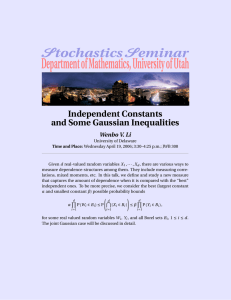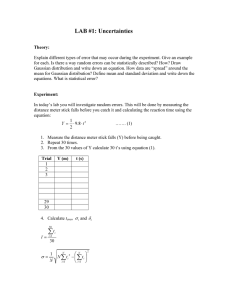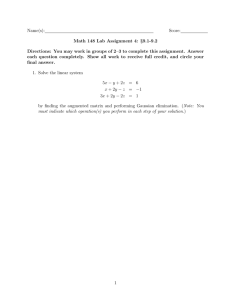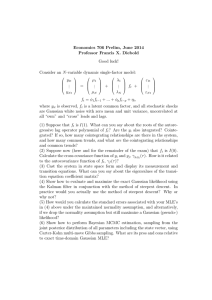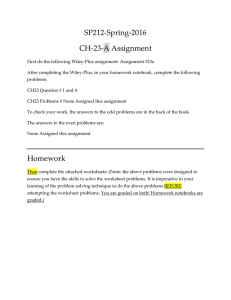Strong data processing inequalities in power-constrained Gaussian channels Please share
advertisement
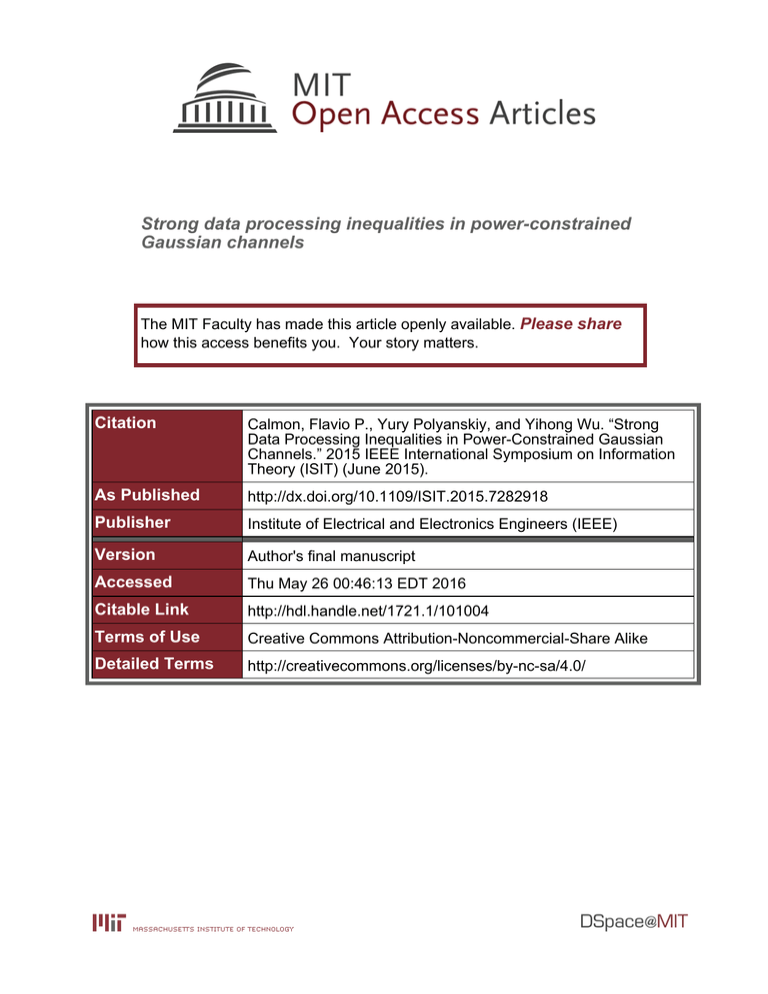
Strong data processing inequalities in power-constrained
Gaussian channels
The MIT Faculty has made this article openly available. Please share
how this access benefits you. Your story matters.
Citation
Calmon, Flavio P., Yury Polyanskiy, and Yihong Wu. “Strong
Data Processing Inequalities in Power-Constrained Gaussian
Channels.” 2015 IEEE International Symposium on Information
Theory (ISIT) (June 2015).
As Published
http://dx.doi.org/10.1109/ISIT.2015.7282918
Publisher
Institute of Electrical and Electronics Engineers (IEEE)
Version
Author's final manuscript
Accessed
Thu May 26 00:46:13 EDT 2016
Citable Link
http://hdl.handle.net/1721.1/101004
Terms of Use
Creative Commons Attribution-Noncommercial-Share Alike
Detailed Terms
http://creativecommons.org/licenses/by-nc-sa/4.0/
1
Strong Data Processing Inequalities in
Power-Constrained Gaussian Channels
Flavio P. Calmon, Yury Polyanskiy, Yihong Wu
Abstract—This work presents strong data processing results
for the power-constrained additive Gaussian channel. Explicit
bounds on the amount of decrease of mutual information under convolution with Gaussian noise are shown. The analysis
leverages the connection between information and estimation (IMMSE) and the following estimation-theoretic result of independent interest. It is proved that any random variable for which
there exists an almost optimal (in terms of the mean-squared
error) linear estimator operating on the Gaussian-corrupted
measurement must necessarily be almost Gaussian (in terms of
the Kolmogorov-Smirnov distance).
I. I NTRODUCTION
Strong data-processing inequalities quantify the decrease
of mutual information under the action of a noisy channel.
Such inequalities have apparently been first discovered by
Ahlswede and Gács in a landmark paper [1]. Among the
work predating [1] and extending it we mention [1]–[5].
Notable connections include topics ranging from existence and
uniqueness of Gibbs measures and log-Sobolev inequalities to
performance limits of noisy circuits. We refer the reader to the
introduction in [6] and the recent monographs [7], [8] for more
detailed discussions of applications and extensions. Below we
only review the necessary minimum to set the stage for our
work.
For a fixed channel PY |X : X → Y, let PY |X ◦ P be
the distribution on Y induced by the push-forward of the
distribution P . One approach to strong data processing seeks
to find the contraction coefficients
Df PY |X ◦ P kPY |X ◦ Q
,
(1)
ηf , sup
Df (P kQ)
P,Q:P 6=Q
where the Df (P kQ) is an arbitrary f -divergence of
Csiszár [9]. When the divergence Df is the KL-divergence
and total variation1 , we denote the coefficient ηf as ηKL and
ηTV , respectively.
For discrete channels, [1] showed equivalence of ηKL < 1,
ηTV < 1 and connectedness of the bipartite graph describing
the channel. Having ηKL < 1 implies reduction in the
usual data-processing inequality for mutual information [10,
Exercise III.2.12], [11]:
∀ W → X → Y : I(W ; Y ) ≤ ηKL · I(W ; X) .
When PY |X is an additive white Gaussian noise channel,
i.e. Y = X +Z with Z ∼ N (0, 1), the authors showed [6] that
F. P. Calmon and Y. Polyanskiy are with the Department of EECS,
MIT, Cambridge, MA, 02139, USA. E-mail:{flavio,yp}@mit.edu. Y. Wu
is with the Department of ECE and the Coordinated Science Lab, University of Illinois at Urbana-Champaign, Urbana, IL, 61801, USA. E-mail:
yihongwu@illinois.edu.
This work is supported in part by the National Science Foundation (NSF)
CAREER award under Grant CCF-12-53205, the NSF Grant IIS-1447879 and
CCF-1423088 and by the Center for Science of Information (CSoI), an NSF
Science and Technology Center, under Grant CCF-09-39370.
1 The total variation between two distributions P and Q is TV(P, Q) ,
supE |P [E] − Q[E]|.
restricting maximization in (1) to distributions with a bounded
second moment (or any moment) still leads to no-contraction,
giving ηKL = ηTV = 1 for AWGN. Nevertheless, the
contraction does indeed take place, except not multiplicatively.
Namely [6] found the region
(TV(P, Q), TV(P ∗ PZ , Q ∗ PZ )) : E(P +Q)/2 [X 2 ] ≤ γ ,
where ∗ denotes convolution. The boundary of this region,
deemed the Dobrushin curve of the channel, turned out to
be strictly bounded away from the diagonal (identity). In
other words, except for the trivial case where TV(P, Q) = 0,
total variation decreases by a non-trivial amount in Gaussian
channels.
Unfortunately, the similar region for KL-divergence turns
out to be trivial, so that no improvement in the inequality
D(PX ∗ PZ kQZ ∗ PZ ) ≤ D(PX kQX )
is possible (given the knowledge of the right-hand side and
moment constraints on PX and QX ). In [6], in order to
study how mutual information dissipates on a chain of Gaussian links, this problem was resolved by a rather lengthy
workaround which entails first reducing questions regarding
the mutual information to those about the total variation and
then converting back.
A more direct approach, in the spirit of the joint-range idea
of Harremoës and Vajda [12], is to find (or bound) the best
possible data-processing function FI defined as follows.
√
Definition 1. Let Yγ = γX + Z, where Z ∼ N (0, 1) is
independent of X. We define
FI (t, γ) , sup {I(W ; Yγ ) : I(W ; X) ≤ t, W → X → Yγ } ,
(2)
where the supremum
is over all joint distributions PW,X such
that E X 2 ≤ 1.
The significance of the function FI is that it gives the
optimal input-independent strong data processing inequality
on Gaussian channel:
I(W ; Yγ ) ≤ FI (I(W ; X), γ).
Before discussing properties of FI , we mention two related
quantities considered previously in the literature. Witsenhausen and Wyner [13] defined
FH (PXY , h) = inf H(Y |W ),
(3)
with the infimum taken over all joint distributions satisfying
W → X → Y, H(X|W ) = h, P[X = x, Y = y] = PXY (x, y) .
Clearly, by a simple reparametrization h = H(X) − t, this
function would correspond to H(Y ) − FI (t) if FI (t) were
defined with restriction to a given input distribution PX .
The PX -independent version of (3) has also been studied by
2
-#
FI
log10 gd (t, 1)
I(W ; Y )
gh
gd
-$
-%
-(
-"
-'
-&
I(W ; X)
Fig. 1. The strong data processing function FI and gaps gd and gh to the
trivial data processing bound (4).
!
! "
!#
!#"
!$
!$"
!%
t
Fig. 2. Lower bound on gd (t, 1) derived in Theorem 1.
% '
)'(
FH (PY |X , h) = inf H(Y |W ),
with the infimum taken over all
W → X → Y, H(X|W ) = h, P[Y = y|X = x] = PY |X (y|x) .
This quantity plays a role in a generalization of Mrs. Gerber’s
lemma and satisfies a convenient tensorization property:
FH ((PY |X )n , nh) = nF (PY |X , h) .
ln ln 1/gh (t, 1)
Witsenhausen [14]:
)'
$'(
$'
&'(
&'
!
"
#
$
%
%!
t
Fig. 3. Lower bound on gh (t, 1) derived in Theorem 2.
There is no one-to-one correspondence between FH (PY |X , h)
and FI (t) and in fact, alas, FI (t) does not satisfy any (known
to us) tensorization property.
Apriori, the only bounds we can state on FI are consequences of capacity and the data processing inequality:
FI (t, γ) ≤ min {t, C(γ)} ,
(4)
FI (t, γ) ≤ t − gd (t, γ),
FI (t, γ) ≤ C(γ) − gh (t, γ)
(5)
(6)
where C(γ) = 21 ln(1 + γ) is the Gaussian channel capacity.
Recently, we were able to show (for any noise distribution
PZ subject to natural regularity conditions) the following two
inequalities hold [15]
with strictly positive gd and gh . See Fig. 1 for an illustration.
Extracting explicit expressions for gd and gh from [15] appears
tedious, however.
In this work, we treat the special case of the Gaussian noise
and derive explicit asymptotically sharp estimates showing that
FI (t, γ) is strictly bounded away from the trivial (4). To that
end, we leverage Fourier-analytic tools and methods specific
to Gaussian distributions, namely, Talagrand’s transportation
inequality [16] and information-estimation connection [17].
Specifically, Theorem 1 provides a lower bound for the
function gd (t, γ) defined in (5), which is asymptotically tight
as t → 0:
γ
1
1
gd (t, γ) = e− t ln t +Θ(ln t ) .
(7)
A repeated application of (5) shows that the mutual information between the input X0 and the output Yn of the chain
of n energy-constrained Gaussian relays converges to zero
I(X0 ; Yn ) → 0. In fact, (7) recovers the convergence rate
of O( logloglogn n ) first reported in [6, Theorem 1].
We also characterize the asymptotic behaviour of FI (t, γ)
approaching C(γ) as t → ∞, which turns out to be doubleexponential. In Theorem 2 and Remark 4, we prove that
gh (t, γ), defined in (6), satisfies
4t
t
e−c1 (γ)e ≤ gh (t, γ) ≤ e−c2 (γ)e
+O(ln γ)
(8)
as t → ∞, where c1 (γ) and c2 (γ) are strictly positive
functions of γ. The lower bounds for gd and gh are illustrated
in Fig. 2 and 3.
In order to bound gh (t, γ) from below, we obtain two
ancillary results that are of independent interest. Lemma 1
shows that if the linear estimator of X given Yγ is near-optimal
in terms of the mean squared error, then X is almost Gaussian
in terms of Kolmogorov-Smirnov (KS) distance. By applying
the I-MMSE relationship, this result is then used to prove that
if I(X; Yγ ) is close to C(γ), then X is also almost Gaussian
in terms of the KS-distance (Lemma 2).
The rest of the paper is organized as follows. Section II
presents a lower bound for gd (t, γ). Section III describes
explicit upper bounds for the KS-distance between the distribution of X and N (0, 1) when (i) the linear estimator of X
given Yγ performs almost as well as the mmse estimator, and
(ii) I(X; Yγ ) is close to C(γ). These results are then used in
Section IV to lower bound gh (t, γ). Finally, in Section V we
consider the infinite-dimensional discrete Gaussian channel,
and show that in this case there exists no non-trivial strong
data processing inequality for mutual information.
II. D IAGONAL B OUND
In this section we show that FI (t) is bounded away from
t for all t > 0 (Theorem 1) and investigate the behaviour of
FI (t) for small t (Corollary 1).
Theorem 1. For t ≥ 0, FI (t, γ) = t − gd (t, γ),where
r x γ γ
t − h (x) − ln 1 +
,
gd (t, γ) ≥ max 2Q
x
2
x
x∈[0,1/2]
(9)
R∞
2
1
h(x) , x ln x1 +(1−x) ln 1−x
and Q(x) , √12π x e−y /2 dy.
3
Proof. Let E = 1{|X|>A/√γ} and E [E] = p. Observe that
E γX 2 |E = 1 ≤ γ/p and p ≤ γ/A2 .
(10)
Therefore, for p̄ , 1 − p,
I(W ; Y ) ≤I(W ; E) + pI(W ; Y |E = 1) + p̄I(W ; Y |E = 0)
≤I(W ; E) + pI(W ; Y |E = 1)
+ p̄η(A)I(W ; X|E = 0),
(11)
where the last inequality follows from [6], and η(t) = 1 −
2Q(t). Noting that
p̄I(W ; X|E = 0) =I(W ; X) − pI(W ; X|E = 1) − I(W ; E),
we can further bound (11) by
I(W ; Y ) ≤ (1 − η(A))I(W ; E) + η(A)I(W ; X)
+ pη(A) (I(W ; Y |E = 1) − I(W ; X|E = 1))
+ p(1 − η(A))I(W ; Y |E = 1)
≤ (1 − η(A)) (I(W ; E) + pI(W ; Y |E = 1))
+ η(A)I(W ; X)
(12)
= I(W ; X) − (1 − η(A)) (I(W ; X)
−I(W ; E) − pI(W ; Y |E = 1)) ,
(13)
where (12) follows from I(W ; Y |E = 1) ≤ I(W ; X|E = 1).
Now observe that, for p = γ/A2 ≤ 1/2,
I(W ; E) ≤ H(E) ≤ h γ/A2 .
(14)
In addition,
pI(W ; Y |E = 1) ≤ pI(X; Y |E = 1)
p
γ
≤ ln 1 +
(15)
2
p
γ
ln(1 + A2 ).
(16)
≤
2A2
Here (15) follows from the fact that mutual information is
maximized when X is Gaussian under the power constraint
(10), and (16) follows by noticing that x 7→ x ln(1 + a/x) is
monotonically increasing
for any a > 0. Combining (14) and
√
(16), and for A ≥ 2γ,
γ γ
+
ln A2 + 1 .
I(W ; E) + pI(W ; Y |E = 1) ≤ h
2
2
A
2A
(17)
p
Choosing A = γ/x, where 0 ≤ x ≤ 1/2, (17) becomes
x γ
I(W ; E) + pI(W ; Y |E = 1) ≤ h (x) + ln 1 +
.
2
x
(18)
Substituting (18) in (13) yields the desired result.
Remark 1. Note that fd (x, γ) , h (x) + x2 ln 1 + γx is 0
when x = 0 and is continuous and strictly positive for 0 <
x ≤ 1/2. Then gd (t, γ) is strictly positive for t > 0. The next
corollary characterizes the behaviour of gd (t, γ) for small t.
Corollary 1. For fixed γ, t = 1/u and u sufficiently large,
there is a constant c3 (γ) > 0 dependent on γ such that
c3 (γ)
gd (1/u, γ) ≥ √
e−γu ln u .
u uγ ln u
(19)
3/2
In particular, gd (1/u, γ) ≥ e−γu ln u+O(ln γu
)
.
Remark 2. Fix γ and define a binary random variable X
with P[X = a] = 1/a2 and P[X = 0] = 1 − 1/a2 for a > 0.
Furthermore, let X̂ denote the minimum distance estimate of
X produced from Yγ . Then the probability of error satisfies
√
√
Pe = P[X 6= X̂] ≤ Q( γa/2). In addition, h Q( γa/2) =
2
√
O(e−γa /8 γa) and H(X) = a−2 ln a(2 + o(1)) as a → ∞.
Therefore,
γ
1
√
(20)
h (Q( γa/2)) ≤ e− H(X) ln H(X) +O(ln(γ/H(X)) .
Using Fano’s inequality, I(X; Yγ ) can be bounded as
I(X; Yγ ) ≥ I(X; X̂)
≥ H(X) − h(Pe )
√
≥ H(X) − h (Q( γa/2))
γ
1
= H(X) − e− H(X) ln H(X) +O(ln(γ/H(X)) .
Setting W = X, this result yields the sharp asymptotics (7).
III. MMSE
We now show that if the linear least-square error of estimating X from Yγ is small (i.e. close to the minimum meansquared error), then X must be almost Gaussian in terms of
the KS-distance. With this result in hand, we use the I-MMSE
relationship [17] to show that if I(X; Yγ ) is close to C(γ),
then X is also almost Gaussian. This result, in turn, will be
applied in the next section to bound FI (t, γ) aways from C(γ).
Denote the linear least-square error estimator of X given
√
Yγ by fL (y) , γy/(1 + γ), whose mean squared error is
lmmse(X|Yγ ) , E (X − fL (Yγ ))2 =
1
.
1+γ
Assume that lmmse(X|Yγ ) − mmse(X|Yγ ) ≤ ǫ. It is well
known that ǫ = 0 if and only if X ∼ N (0, 1) (e.g. [18]). To
develop a finitary version of this result, we ask the following
question: If ǫ is small, how close is PX to Gaussian? The next
lemma provides a quantitative answer.
Lemma 1. If lmmse(X|Yγ ) − mmse(X|Yγ ) ≤ ǫ, then there
are absolute constants a0 and a1 such that
s
1
dKS (FX , N (0, 1)) ≤a0
γ log(1/ǫ)
p
+ a1 (1 + γ)ǫ1/4 γ log(1/ǫ), (21)
where FX is the CDF of X, and dKS is the KolmogorovSmirnov distance, defined as dKS (F1 , F2 ) , supx∈R |F1 (x) −
F2 (x)|.
Remark 3. Note that the gap between the linear and nonlinear MMSE can be expressed as the Fisher distance between the convolutions, i.e., lmmse(X|Y
γ) =
R γ ) − mmse(X|Y
dP ′ 2
) ] dP is the
I(PYγ kN (0, 1+γ)), where I(P kQ) = [(log dQ
Fisher distance, which is very strong and dominates the KL
divergence according to the log-Sobolev inequality. Therefore
Lemma 1 can be interpreted as a deconvolution result, where
bounds on a stronger (Fisher) distance of the convolutions lead
to bounds on the distance between the original distributions
under a weaker (KS) metric.
4
Proof. Denote fM (y) = E [X|Yγ = y]. Then
lmmse(X|Yγ ) − mmse(X|Yγ )
=E (X − fL (Yγ ))2 − E (X − fM (Yγ ))2
=E (fM (Yγ ) − fL (Yγ ))2 ≤ ǫ.
(22)
Denote
∆(y)
, fM (y) − fL (y). Then E [∆(Yγ )] = 0 and
E ∆(Yγ )2 ≤ ǫ. From the orthogonality principle:
(23)
E eitYγ (X − fM (Yγ )) = 0.
Let ϕX denote the characteristic function of X. Then
E eitYγ (X − fM (Yγ )) = E eitYγ (X − fL (Yγ ) − ∆(Yγ ))
1 −t2 /2 h i√γtX i √
√
E e
e
=
X − γϕX ( γt)E ZeitZ
1+γ
− E eitYγ ∆(Yγ )
2
=
−ie−u /2γ ′
(ϕX (u) + uϕX (u)) − E eitYγ ∆(Yγ ) , (24)
1+γ
where the last equality follows by changing variables u =
√
γt. Consequently,
Lemma 2. Let C(γ) − I(X; Yγ ) ≤ ǫ. Then, for γ > 4ǫ,
s
2
dKS (FX , N (0, 1)) ≤a0
γ
γ ln 4ǫ
r
γ
+ a1 (1 + γ)(γǫ)1/4 2 ln
. (29)
4ǫ
IV. H ORIZONTAL B OUND
In this section we show that FI (t, γ) is bounded away from
the capacity C(γ) for all t. In particular, Theorem 2 proves
that if C(γ) − FI (t, γ) ≤ ǫ, then t = Ω(ln ln 1/ǫ) as ǫ → 0.
We first give an auxiliary lemma.
Lemma 3. If D(N (0, 1)kPX ∗N (0, 1)) ≤ 2ǫ, then there exists
an absolute constant a2 > 0 such that
P[|X| > ǫ1/8 ] ≤ a2 ǫ1/8 .
Theorem 2. Let C(γ) − FI (t, γ) ≤ ǫ. Then
1
1
ln ln − ln c1 (γ),
(31)
4
ǫ
where c1 (γ) is some constant depending on γ. In particular,
t≥
2
e−u /2γ ′
|ϕX (u) + uϕX (u)| = E eitYγ ∆(Yγ ) 1+γ
√
≤ E [|∆(Yγ )|] ≤ ǫ.
2
Put φX (u) = e−u
/2
|ϕ′X (u)
(1 + z(u)). Then
+ uϕX (u)| = e
−u2 /2
′
|z (u)|,
√
and, from (26), |z ′ (u)| ≤ (1 + γ) ǫe
. Since z(0) = 0,
Z u
√ u2 (γ+1)
|z ′ (x)|dx ≤ u(1 + γ) ǫe 2γ .
|z(u)| ≤
(27)
u2 (γ+1)
2γ
0
2
2
Observe that |ϕX (u) − e−u /2 | = e−u /2 |z(u)|. Then, from
(27),
ϕ (u) − e−u2 /2 √ u2
X
(28)
≤ (1 + γ) ǫe 2γ .
u
Thus the Esseen inequality (cf. [19, Eq. (3.13), pg. 512]) yields
√
Z
√ u2
12 2
1 T
2γ
dKS (FX , N (0, 1)) ≤
(1 + γ) ǫe du + 3/2
π −T
π T
√
√ T2
2T
12 2
(1 + γ) ǫe 2γ + 3/2 .
≤
π
π T
q
γ
1
Choosing T = 2 ln( ǫ ), we find
s
1
dKS (FX , N (0, 1)) ≤a0
γ ln(1/ǫ)
p
+ a1 (1 + γ)ǫ1/4 γ ln(1/ǫ),
where a0 =
24
π 3/2
and a1 =
FI (t, γ) = C(γ) − gh (t, γ),
(25)
(26)
√
2
π .
Through the I-MMSE relationship [17], the previous lemma
can be extended to bound the KS-distance between the distribution of X and the Gaussian distribution when I(X; Yγ ) is
close to C(γ).
(30)
where gh (t, γ) ≥ e
−c1 (γ)e4t
(32)
.
Proof. Let C(γ) − I(W ; Yγ ) ≤ ǫ. Observe that
I(W ; Yγ ) =C(γ) − D(P√γX ∗ N (0, 1)kN (0, 1 + γ))
− I(X; Yγ |W ).
(33)
Therefore, if I(W ; Yγ ) is close to C(γ), then (a) PX needs
to be Gaussian like, and (b) PX|W needs to be almost deterministic with high PW -probability. Consequently, PX|W and
PX are close to being mutually singular and hence I(W ; X)
will be large, since
I(W ; X) = D(PX|W kPX |PW ).
√
Let X̃ , γX and then W → X̃ → Y . Define
d(x, w) , D(PY |X̃=x kPY |W =w )
= D(N (x, 1)kPX̃|W =w ∗ N (0, 1)).
Then (x, w) 7→ d(x, w) is jointly measurable2 and
I(X; Y |W ) = E[d(X̃, W )]. Similarly, w 7→ τ (w) ,
D(PX|W =w kPX ) is measurable and I(X; W ) = E[τ (W )].
Since ǫ ≥ I(X; Y |W ) in view of (33), we have
ǫ ≥ E[d(X̃, W )] ≥ 2ǫ · P[d(X̃, W ) ≥ 2ǫ].
(34)
Therefore
P[d(X̃, W ) < 2ǫ] >
1
.
2
(35)
Denote B(x, δ) , [x − δ, x + δ]. In view of Lemma 3, if
2 By definition of the Markov kernel, x 7→ P
Y ∈A|X̃=x and w 7→
PY ∈A|W =w are both measurable for any measurable subset A. Since Y
is real-valued, by data processing and lower semicontinuity of divergence, we
have D(P[Y ] |X̃=x kP[Y ]k |W =w ) → D(PY |X̃=x kPY |W =w ) as k → ∞,
k
where [y]k = ⌊ky⌋/k denotes the uniform quantizer. Therefore the joint
measurability of (x, w) 7→ D(PY |X̃=x kPY |W =w ) follows from that of
(x, w) 7→ D(P[Y ] |X̃=x kP[Y ]k |W =w ).
k
5
d(x, w) < 2ǫ, then
1/8
P[X̃ ∈ B(x, ǫ )|W = w]
x ǫ1/8 W = w ≥ 1 − a2 ǫ1/8 .
=P X ∈ B √ , √
γ
γ Therefore, with probability at least 1/2, X̃ and, consequently,
X is concentrated on a small ball. Furthermore, Lemma 2
implies that there exist absolute constants a3 and a4 such that
x ǫ1/8
P X∈B √ , √
γ
γ
x ǫ1/8
≤P Z∈B √ , √
+ 2dKS (FX , N (0, 1))
γ
γ
s
√ 1/8
r 2ǫ
1
γ
1/4
+ a4 (1 + γ)(γǫ)
ln
≤ √
+ a3
γ
πγ
4ǫ
γ ln 4ǫ
−1/2
1
,
≤ κ(γ) ln
ǫ
estimate (4) as d → ∞. It turns out this dependence is
unavoidable as we show next.
To that end we consider an infinite-dimension discrete-time
Gaussian channel. Here the input X = (X1 , X2 , . . . ) and Y =
(Y1 , Y2 , . . . ) are sequences, where Yi = Xi + Zi and Zi ∼
N (0, 1) are i.i.d. Similar to Definition 1, we denote
FI∞ (t, γ) = sup {I(W ; Y ) : I(W ; X) ≤ t, W → X → Y } ,
(38)
2
=
where
the
supremum
is
over
all
P
such
that
E
kXk
W
X
2
P 2 E
Xi
≤ γ. Note that, in this case, FI∞ (t, γ) ≤
min{t, γ/2}. The next theorem shows that unlike in the scalar
case, there is no improvement over the trivial upper bound
(38) in the infinite-dimensional case. This is in stark contrast
with the strong data processing behavior of total variation in
Gaussian noise which turns out to be dimension-independent
[6, Corollary 6].
Theorem 3. For 0 ≤ t ≤ γ/2, FI∞ (t, γ) = t.
R EFERENCES
[1] R. Ahlswede and P. Gács, “Spreading of sets in product spaces and
where κ(γ) is some positive constant depending only on γ.
hypercontraction of the Markov operator,” The Annals of Probability,
Therefore, for any w ∈ B and ǫ sufficiently small, denoting
pp. 925–939, 1976.
1/8
[2] R. Dobrushin, “Central limit theorem for nonstationary Markov chains.
E = B( √xγ , ǫ√γ ), we have by data processing inequality:
I,” Theory of Probab Appl., vol. 1, no. 1, pp. 65–80, Jan. 1956.
[3] O. Sarmanov, “Maximum correlation coefficient (nonsymmetric case),”
PX|W =w (E)
Selected Translations in Mathematical Statistics and Probability, vol. 2,
τ (w) = D(PX|W =w kPX ) ≥PX|W =w (E) ln
pp. 207–210, 1962.
PX (E)
c [4] J. Cohen, Y. Iwasa, G. Rautu, M. Ruskai, E. Seneta, and G. Zbaganu,
PX|W =w (E )
“Relative entropy under mappings by stochastic matrices,” Linear alge+ PX|W =w (E c ) ln
bra and its applications, vol. 179, pp. 211–235, 1993.
PX (E c )
[5] R. Subramanian, B. Vellambi, and I. Land, “An improved bound on
1
1
information loss due to finite block length in a Gaussian line network,”
≥ ln ln − ln κ(γ) − a5 , (36)
in Proc. 2013 IEEE Int. Symp. on Inf. Theory, Jul. 2013, pp. 1864–1868.
2
ǫ
[6] Y. Polyanskiy and Y. Wu, “Dissipation of information in channels with
where a5 is an absolute positive constant. Combining (36) with
input constraints,” arXiv:1405.3629 [cs, math], May 2014.
[7] M. Raginsky, “Strong data processing inequalities and φ-Sobolev in(35) and letting c21 (γ) , ea5 κ(γ), we obtain
equalities for discrete channels,” arXiv:1411.3575 [cs, math], Nov. 2014.
i
h
1
1
1
[8] M. Raginsky and I. Sason, “Concentration of measure inequalities in
P τ (W ) ≥ ln ln − 2 ln c1 (γ) ≥ P[d(X̃, W ) < 2ǫ] ≥ ,
information theory, communications, and coding,” Found. and Trends in
2
ǫ
2
Comm. and Inf. Theory, vol. 10, no. 1-2, pp. 1–247, 2013.
[9] I. Csiszár, “Information-type measures of difference of probability
which implies that I(W ; X) = E[τ (W )] ≥ 14 ln ln 1ǫ −
distributions and indirect observation,” Studia Sci. Math. Hungar., vol. 2,
ln c1 (γ), proving the desired (31).
pp. 229–318, 1967.
Csiszár and J. Körner, Information Theory: Coding Theorems for
Remark 4. The double-exponential convergence rate in The- [10] I.Discrete
Memoryless Systems. New York: Academic, 1981.
orem 2 is in fact sharp. To see this, note that [20, Theorem [11] V. Anantharam, A. Gohari, S. Kamath, and C. Nair, “On maximal
correlation, hypercontractivity, and the data processing inequality studied
8] showed that there exists a sequence of zero-mean and unitby Erkip and Cover,” arXiv preprint arXiv:1304.6133, 2013.
variance random variables Xm with m atoms, such that
[12] P. Harremoës and I. Vajda, “On pairs of-divergences and their joint
2m
range,” IEEE Trans. Inform. Theory, vol. 57, no. 6, pp. 3230–3235,
γ
√
2011.
. (37)
C(γ) − I(Xm ; γXm + Z) ≤ 4(1 + γ)
[13] H. Witsenhausen and A. Wyner, “A conditional entropy bound for a
1+γ
pair of discrete random variables,” IEEE Trans. Inform. Theory, vol. 21,
Consequently,
no. 5, pp. 493–501, Sep. 1975.
[14] H. Witsenhausen, “Entropy inequalities for discrete channels,” IEEE
t
Trans. Inform. Theory, vol. 20, no. 5, pp. 610–616, Sep. 1974.
C(γ) − FI (t, γ) ≤ C(γ) − FI (ln⌊e ⌋, γ)
[15] Y. Polyanskiy and Y. Wu, “Strong data-processing of mutual informa2(et −1)
tion: beyond Ahlswede and Gács,” in Proc. Information Theory and
γ
≤ 4(1 + γ)
Applications Workshop, 2015.
1+γ
[16] M. Talagrand, “Transportation cost for Gaussian and other product
1+γ
t
measures,” Geom. Funct. Anal., vol. 6, no. 3, pp. 587–600, May 1996.
= e−2e ln γ +O(ln γ) ,
[17] D. Guo, S. Shamai, and S. Verdu, “Mutual information and minimum
mean-square error in Gaussian channels,” IEEE Trans. on Inform.
proving the right-hand side of (8).
Theory, vol. 51, no. 4, pp. 1261–1282, Apr. 2005.
[18] D. Guo, Y. Wu, S. Shamai, and S. Verdú, “Estimation in Gaussian
V. D IMENSION GREATER THAN 1
Noise: Properties of the Minimum Mean-Square Error,” IEEE Trans.
Inf. Theory, vol. 57, no. 4, pp. 2371–2385, Apr. 2011.
It is possible to reproduce the techniques above for the
[19] W. Feller, An Introduction to Probability Theory and Its Applications,
case when the channel X → Y is a d-dimensional
Gaussian
P 2 Vol. 2, 1st ed. New York: Wiley, 1966.
channel subject to a total-energy constraint E
[20] Y. Wu and S. Verdú, “The impact of constellation cardinality on
i Xi ≤ 1 .
Gaussian channel capacity,” in Proc. 48th Annual Allerton Conf. on
Unfortunately, the resulting bound has strong dependence
Commun., Control, and Comput., Sep. 2010, pp. 620–628.
on dimension and in particular does not improve the trivial
